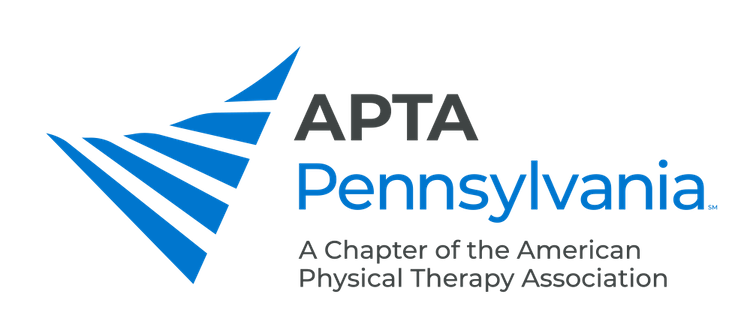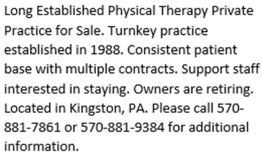|
MELISSA SELL, PTA - PTA SIG CHAIR: [email protected] How long have you been a PTA? It will be 3 years. What program did you graduate from? Community College of Allegheny County- Boyce Campus (ccac.edu) What led to a PTA career? I had worked as a rehabilitation technician for a number of years and was intrigued by the PTA career. I knew that I wanted to advance my skills professionally, but PT school wasn’t in the cards for me but being a PTA seemed like a perfect fit for me and I’ve been happy with that decision ever since. What setting do you currently work? What settings have you worked in the past? Out-patient, and always have. I currently work with both orthopedic and neurologic patients. What sparked your interest in working in your current area? I have always loved the out-patient setting as you could follow a patient’s plan of care from start to finish and help them reach their goals along the way. However, when I was in school, one of my clinical locations was at a local hospital on a rehab floor specializing in treating patients who had recently undergone organ transplants or had suffered from a stroke. This opened my eyes to a whole new type of treatment and one that I had loved just as much, if not more, than orthopedics. I find that working in both settings helps me to be a better clinician overall. But no matter who is in front of me, or why they are coming for skilled services, their goals are my number one and the focus from session to session. What is your work environment with PT’s and PTA’s? I am the only PTA in the office and I work alongside 2 orthopedic PT’s and one PT who specializes in treating our neurological caseload. There is also an occupational and speech therapist in my office. I’m also the only one in the office who treats both orthopedic and neuro patients so my days can be really interesting with who I see from day to day. Tell us about a patient experience that made you proud to be a PTA? Or any other proud moments you have had so far? One of my most recent “success” stories comes from one of the neuro patients I had the honor of treating. When said patient came to us, he had recently suffered a stroke which greatly affected the L side of his body. Whenever we would stand with the patient we had to use a KAFO and maximum assistant in the parallel bars. As each week went on, the patient got stronger and stronger and we were able to go from maximum assistance to minimum, and then from the KAFO to the AFO. We started gait training through the clinic over ground as the patient gained confidence and functional strength. He was incredibly motivated to improve and gain his life back...fast forward a number of months and the patient was able to walk his daughter down the aisle on her wedding day.
VICKI TOBIN, PTA – PTA SIG VICE CHAIR: [email protected] How long have you been a PTA? - 21 Years What program did you graduate from? Harcum College (harcum.edu) What led to a PTA career? I always had an interest in the medical field - the thought of directly helping people but during high school I struggled with science - mainly chemistry - and talked myself out of a career in the medical field. I shifted to the legal field and was a paralegal/legal secretary for six years and became jaded. One night I was watching a TV movie about a football player that was paralyzed during a game and the movie highlighted his rehab and I thought hey, I can do that. So I researched and wanted to find a way to get into the field quickly and found Harcum College’s PTA program and as they say, the rest is history. What setting do you currently work? I have been working in the Acute Care setting for 14 years. Also work subacute rehab on the weekends. What settings have you worked in the past? Outpatient, pediatric outpatient What sparked your interest in working in your current area? I like the idea of being there at the beginning of a patients journey to recovery. Also the variety of patients I work with - organ transplants, TBI, trauma, falls, etc. Are you a clinical instructor? Yes What is challenging about being a CI? The different personalities of students and adjusting to their learning styles. What is rewarding about being a CI? Showing off the PTA profession and showing the students what they are capable of doing/being as a PTA. Watching the student learn and grow professional t/o their clinical. Why did you become a member of the APTA? I was not an APTA member for a while but then I realized, we need to advocate for our great profession, specifically PTAs. We are a great asset to the profession, and we can do so much for our patients and profession. Our voices can be as loud as anyone’s. And what keeps you inspired to stay with the APTA? Fellow members, the networking. The pride everyone has in this profession and the impact members have on issues. I participated in Advocacy Day in Washington and spoke with legislators regarding bills that affect our profession. Public speaking terrifies me but being having the opportunity to advocate and promote the PT/PTA profession and being surrounded by other PTs/PTAs/students advocating, I felt at ease and was able to speak clearly and strongly with legislators and their staff members. I plan to participate in Advocacy Day again. Strongly encourage that if you have a chance to participate, please do. The more voices a choir has, the more beautiful the song!
CHRIS CLARK, PTA – PTA SIG SECRETARY: [email protected] How long have you been a PTA? 23 years What program did you graduate from? Harcum College (harcum.edu) What led to a PTA career? This was a 2nd career for me. I was missing out on growth, advancement and job fulfillment. When I searched for a new career and came across PTA I remembered when my mother was hospitalized she worked with physical therapy. She gave the therapist a difficult time, she made a big fuss about having to get out of bed to walk but after PT left she said how much better she felt and I saw her mood be lifted. I found an evening program near my home and was able to complete my Associates degree. Do you have any specialty certifications? Why did you choose this specialty? How did you achieve this specialty? TPS - Therapeutic Pain Specialist for 8 years. From EIM - It was a 6 month hybrid program. (evidenceinmotion.com/program/therapeutic-pain-specialist-tps-certification) The reason I wanted to specialize in this area was to learn more about pain - what was I missing. I would work with people that I just would not be able to help. Plus there are always some people that stick with you. I worked with a 9 y.o. that was sitting in the back seat of a car that was involved in an accident. There was a spine fracture. When she started outpatient her fracture was completely healed, she improved functionally, met her goals but her pain remained. LSVT for Parkinson’s population for 15 years. This is a 2 day course. I was interested in this course because it was the first evidenced based course for treatment of Parkinsons. It is a great high intensity program that can help improve movement and function. (lsvtglobal.com) What is your work environment with PT’s and PTA’s? I currently work at a hospital based outpatient setting. I am the only PTA - I work alongside 3 Physical Therapists. Our patient population is orthopedic and neurologic. Our clinic has a persistent pain group program run by a PT and me. Do you participate in events or volunteer in the community using your PTA skills? I volunteer with APTA with legislative advocacy. I have attended “day of advocacy” in Washington DC. I felt well prepared because the APTA had good resources to use. It was an amazing experience, and I plan to attend again. If you are interested in attending future advocacy events, please reach out to me. I volunteer for an organization called Life Rolls on - it is adaptive surfing - it allows those with disabilities to get on a surfboard and a large volunteer team takes them into the ocean to catch some waves. I also participate in local senior fares to educate and perform activities for fall prevention. What do you do when you get burned out? (if you have experienced this), I try to stay mindful and aware of the start of feeling burned out. I see what is not balanced in my life and see what I can adjust. Set goals to take time out for myself. Do something that makes me happy and brings me joy such as going to the beach or take time to go out with a friend. I also try to practice breathing and mindfulness techniques throughout the day. Trying to stay aware and ahead of it, I find is the best way to manage it.
|

